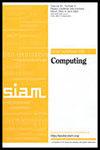具有近似线性块长度和恒定查询复杂度的松弛局部可纠错码
IF 1.6
3区 计算机科学
Q3 COMPUTER SCIENCE, THEORY & METHODS
引用次数: 0
摘要
SIAM计算杂志,第51卷,第6期,1839-1865页,2022年12月。摘要。局部可校正码(lcc)是一种错误校正码[数学],它允许本地算法通过少量查询来纠正损坏码字的任何单个符号。对于系统代码,这个概念比局部可解码代码(ldc)更强,ldc的目标是仅恢复消息的单个符号。算法编码理论的核心问题之一是构造具有最小块长度的[数学]查询lcc和ldc。唉,尽管在过去二十年中受到了很多关注,但这种代码的最新技术需要超多项式块长度才能允许[数学]查询算法进行局部校正和解码。放宽lcc和ldc的研究提供了一种绕过这一障碍的方法,它们允许校正算法在一小部分位置上中断(但不会出错)。事实证明,这种松弛允许对具有多项式块长度的代码进行恒查询纠错和解码算法。Gur, Ramnarayan和Rothblum[第九届理论计算机科学创新会议论文集,ITCS ' 18, 2018, pp. 1-27]专注于局部校正,表明存在[math]-查询放宽lcc,对于任意小的常数[math],实现近四分之一块长度[math]。对于任意小的常数[math],我们构造了一个具有近似线性块长度[math]的[math]查询松弛LCC。这大大缩小了下界之间的差距,下界表明不存在块长度为[math]的[math]查询放宽lcc。特别是,我们的构造与Ben-Sasson等人获得的参数相匹配[SIAM J. Comput]。, 36 (2006), pp. 889-974],他们用相同的参数构建了宽松的最不发达国家。这解决了Gur, Ramnarayan和Rothblum提出的一个开放问题[第九届理论计算机科学创新会议论集,ITCS ' 18, 2018, pp. 1-27]。本文章由计算机程序翻译,如有差异,请以英文原文为准。
Relaxed Locally Correctable Codes with Nearly-Linear Block Length and Constant Query Complexity
SIAM Journal on Computing, Volume 51, Issue 6, Page 1839-1865, December 2022.
Abstract. Locally correctable codes (LCCs) are error correcting codes [math] which admit local algorithms that correct any individual symbol of a corrupted codeword via a minuscule number of queries. For systematic codes, this notion is stronger than that of locally decodable codes (LDCs), where the goal is to only recover individual symbols of the message. One of the central problems in algorithmic coding theory is to construct [math]-query LCCs and LDCs with minimal block length. Alas, state-of-the-art of such codes requires super-polynomial block length to admit [math]-query algorithms for local correction and decoding, despite much attention during the last two decades. The study of relaxed LCCs and LDCs, which allow the correction algorithm to abort (but not err) on a small fraction of the locations, provides a way to circumvent this barrier. This relaxation turned out to allow constant-query correcting and decoding algorithms for codes with polynomial block length. Focusing on local correction, Gur, Ramnarayan, and Rothblum [Proceedings of the 9th Innovations in Theoretical Computer Science Conference, ITCS’18, 2018, pp. 1–27] showed that there exist [math]-query relaxed LCCs that achieve nearly-quartic block length [math], for an arbitrarily small constant [math]. We construct an [math]-query relaxed LCC with nearly-linear block length [math], for an arbitrarily small constant [math]. This significantly narrows the gap between the lower bound which states that there are no [math]-query relaxed LCCs with block length [math]. In particular, our construction matches the parameters achieved by Ben-Sasson et al. [SIAM J. Comput., 36 (2006), pp. 889–974], who constructed relaxed LDCs with the same parameters. This resolves an open problem raised by Gur, Ramnarayan, and Rothblum [Proceedings of the 9th Innovations in Theoretical Computer Science Conference, ITCS’18, 2018, pp. 1–27].
Abstract. Locally correctable codes (LCCs) are error correcting codes [math] which admit local algorithms that correct any individual symbol of a corrupted codeword via a minuscule number of queries. For systematic codes, this notion is stronger than that of locally decodable codes (LDCs), where the goal is to only recover individual symbols of the message. One of the central problems in algorithmic coding theory is to construct [math]-query LCCs and LDCs with minimal block length. Alas, state-of-the-art of such codes requires super-polynomial block length to admit [math]-query algorithms for local correction and decoding, despite much attention during the last two decades. The study of relaxed LCCs and LDCs, which allow the correction algorithm to abort (but not err) on a small fraction of the locations, provides a way to circumvent this barrier. This relaxation turned out to allow constant-query correcting and decoding algorithms for codes with polynomial block length. Focusing on local correction, Gur, Ramnarayan, and Rothblum [Proceedings of the 9th Innovations in Theoretical Computer Science Conference, ITCS’18, 2018, pp. 1–27] showed that there exist [math]-query relaxed LCCs that achieve nearly-quartic block length [math], for an arbitrarily small constant [math]. We construct an [math]-query relaxed LCC with nearly-linear block length [math], for an arbitrarily small constant [math]. This significantly narrows the gap between the lower bound which states that there are no [math]-query relaxed LCCs with block length [math]. In particular, our construction matches the parameters achieved by Ben-Sasson et al. [SIAM J. Comput., 36 (2006), pp. 889–974], who constructed relaxed LDCs with the same parameters. This resolves an open problem raised by Gur, Ramnarayan, and Rothblum [Proceedings of the 9th Innovations in Theoretical Computer Science Conference, ITCS’18, 2018, pp. 1–27].
求助全文
通过发布文献求助,成功后即可免费获取论文全文。
去求助
来源期刊

SIAM Journal on Computing
工程技术-计算机:理论方法
CiteScore
4.60
自引率
0.00%
发文量
68
审稿时长
6-12 weeks
期刊介绍:
The SIAM Journal on Computing aims to provide coverage of the most significant work going on in the mathematical and formal aspects of computer science and nonnumerical computing. Submissions must be clearly written and make a significant technical contribution. Topics include but are not limited to analysis and design of algorithms, algorithmic game theory, data structures, computational complexity, computational algebra, computational aspects of combinatorics and graph theory, computational biology, computational geometry, computational robotics, the mathematical aspects of programming languages, artificial intelligence, computational learning, databases, information retrieval, cryptography, networks, distributed computing, parallel algorithms, and computer architecture.
 求助内容:
求助内容: 应助结果提醒方式:
应助结果提醒方式:


